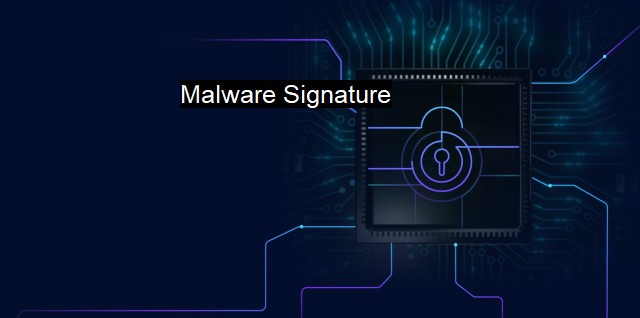What is Malware Signature?
Understanding Malware Signatures: How Antivirus Software is Tackling Cybercrime Through Code Recognition
A malware signature refers to a unique series of bytes, pattern, or hash that denotes a specific type of malicious software. It can also relate to specific traits or behaviors that are associated with malware, such as its structure or method of invasion. Malware signatures are used in the detection and prevention of malicious programs and are critical elements of antivirus software systems. These programs utilise comprehensive databases of malware signatures to scan, detect and thwart digital threats from infecting a computer or network.Think of a malware signature as a fingerprint that can identify an individual in the real world. Each malware variant has a unique signature that helps in confirming its identity and implementation. Therefore, the ability to detect and match these malicious software fingerprints becomes vital in dealing with cyber threats. As the digital world expands, the ability to quickly identify a malware threat by a distinct signature, facilitates efficient security intervention and protects individual computers, networks and the cyberspace at large.
Physical biometrics, such as fingerprints or facial recognition, are primarily used for identifying individuals. Similarly the malware signature of a malignant software program is unique to it and can be crucial to the identification of the software's origin, affiliation and operational strategy.
The creation of a malware signature necessitates a detailed analysis and probing of the malware. Malware researchers and analysts spend countless hours dissecting new malware variants to understand how they function, their structural patterns and unique features, with the aim of distilling their specific signature. These characteristics undergo intense scrutiny under technologies like Static and Dynamic Analysis, Reverse Engineering, Network Traffic Analysis, and more.
Once the malware signatures are extracted, they are incorporated into a database which is used to fortify an existing antivirus system, or form the foundation of a new one. The antivirus software now uses these signatures to scan for invasions in different programs and documents and alerts the user or the network administrator if a match is found. This is a feature almost all modern antiviruses guarantee to an organisation or regular computer user.
The malware signature library forms a vital building block of a robust cybersecurity framework. The continual growth of this library and the need to include newly created malware signatures is part of what makes securing cyberspace a rigorous and challenging endeavor. Cybersecurity teams across the world are constantly on the run, identifying, analyzing, and adding new malware signatures to their libraries to ensure protection against constantly evolving threats.
But malware signature based detection is not always foolproof as cyber miscreants are astute and frequently modify their malicious code to evade identification. This gives rise to polymorphic and metamorphic malware variants that constantly change their signature, making static signature analysis impractical. To overcome this hurdle, cybersecurity companies employ heuristics and behavior-based detection methods that are effective against these sorts of stealthier threats, focusing on the distinctive behaviors of malware rather than just their static signatures.
"malware signatures" are the unique traits or characteristics that assist in the identification and classification of various types of malware. These signatures play a pivotal role in the overall functionality of numerous antivirus software and reinforce a healthy cybersecurity ecosystem. By continually detecting and cataloging new malware signatures from every corner of cyberspace, cybersecurity experts and the solutions they design are improving steadily, overcoming barriers which keep users safe from the most dangerous cyber threats.

Malware Signature FAQs
What is a malware signature?
A malware signature is a unique pattern or code snippet that identifies a specific piece of malware. It is used by antivirus software to recognize and block malware threats.How are malware signatures created?
Malware signatures are created by analyzing malware samples and identifying unique characteristics that can be used to identify the malware. This can include specific file names, code snippets, or behavioral patterns.Is relying solely on malware signatures enough to protect against all cyber threats?
No, relying solely on malware signatures is not enough to protect against all cyber threats. Malware is constantly evolving, and attackers are constantly finding new ways to evade detection. It is important to use a combination of signature-based and behavior-based detection methods to effectively protect against cyber threats.What are the limitations of using malware signatures?
The limitations of using malware signatures include the fact that they are only effective against known threats. This means that new or unknown threats will not be detected until a signature is created for them. Additionally, attackers can often modify or obfuscate their malware to evade detection by antivirus software that relies solely on signature-based detection.| | A | | | B | | | C | | | D | | | E | | | F | | | G | | | H | | | I | | | J | | | K | | | L | | | M | |
| | N | | | O | | | P | | | Q | | | R | | | S | | | T | | | U | | | V | | | W | | | X | | | Y | | | Z | |
| | 1 | | | 2 | | | 3 | | | 4 | | | 7 | | | 8 | | |||||||